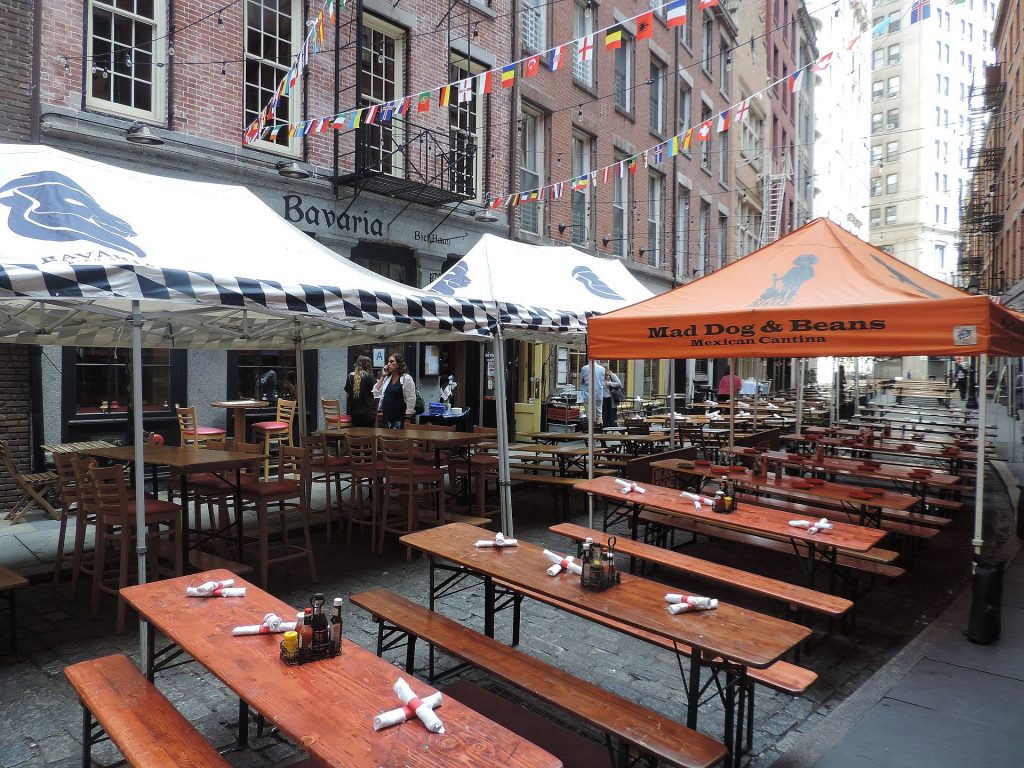One of my favorite neighborhoods in New York City is the Financial District and within that compact area is another NYC treasure: Stone Street.
There are so many sights to see already in the Financial District: the New York Stock Exchange, Wall Street, the World Trade Center. You could probably spend almost an entire day exploring.
As a Lower Manhattan tour guide, I’m often asked to recommend where to visit while downtown. My first answer is always Stone Street.
This tiny block is lined with tables, flags, streetlights, and merry guests, but tourists often miss it because its historic buildings are tucked away behind skyscrapers, and yet it’s worth discovering all on its own for so many reasons. Here are just a few:
- It’s the best place to get food in the Financial District because there are so many restaurants that vary in style to fit multiple tastes.
- The architecture is distinct from the rest of the city. Plus, the road is pedestrian-only, making it one of only a few thoroughfares in New York where you can walk without thinking about traffic.
- The energy is unique here. It almost feels like you’ve left New York. It’s hard to describe, but once you visit, you’ll understand.
Though Stone Street is beloved by locals as a dining hotspot, it’s more than just good food and drinks that make this block special. Here’s everything you need to know about Stone Street, from its history to where to eat and what it’s like to visit today.
The history of Stone Street NYC

Originally known by the Dutch name “Hoogh Straet,” meaning High Street, the current name of Stone Street comes simply from the paving of the road — cobblestones.
Stone Street is one of the city’s oldest streets and was actually the first road to be paved in New Amsterdam, which later became New York. The residents of the block were annoyed with the heavy dust and poor conditions of the street, which resulted in the request to have it paved over.
New Amsterdam
What is New Amsterdam, you ask?
Well, before America was owned by the British, there was a small pocket of land, currently Lower Manhattan, owned by the Dutch West India Trading Company. This land was discovered by Henry Hudson in the early 1600s and later settled by the Dutch in the 1620s. They established the territory as New Amsterdam and prospered here for almost 40 years until it was claimed by the British.
While their time here was short, the Dutch influence on New York and American culture is undeniable. Hobbies like bowling and ice skating, treats like cookies, waffles, and donuts — these all come from the Netherlands. Many New York City streets and neighborhoods (Harlem, Brooklyn, Staten Island) still have their original Dutch names.
Stone Street today
Oddly enough, Stone Street is one of the only physical remnants of New Amsterdam that still exists today.
Like many major American cities, New York suffered through multiple fires that led to the destruction of all the original structures in New Amsterdam. Since the streets are all that survived, they have been protected by the Landmarks Preservation Commission, and Stone Street was designated a historic district. Both the cobblestones that line the street and the buildings along it are some of the oldest remaining architecture in the city.
After the series of fires destroyed the buildings that once stood on the street, lofts were built for dry goods, storage, and merchants. When they eventually fell into despair, these lofts were later rebuilt or reconstructed in Dutch Colonial Revival style, reminiscent of the buildings in New Amsterdam.
Finally, in the early 2000s, Ulysses’, a bar, opened in the middle of the block and became an anchor for a number of other dining establishments that later arrived on the scene.
The architecture of Stone Street

Credit: Gryffindor / CC BY-SA 3.0
As I mentioned above, the architecture of Stone Street really makes it stand out among the other blocks in Lower Manhattan.
Many of the buildings from the 1800s are still standing today and are a sign of a time gone by. Visitors will see brownstones, which are a signature of New York architecture.
Tucked among these brown buildings are also Dutch Colonial Revival-style buildings. These structures sometimes resemble barns, have large windows with shutters, and have a central door. You obviously aren’t going to see a barn on Stone Street, but if you look at 53, 55, or 57 Stone Street, you’ll see those large windows of this architectural style.
There are more buildings constructed in neo-Tudor and neo-Renaissance styles, but visitors to this historic street will most likely just be taken by all the exposed brick that can be seen up and down this corner of NYC.
The brick makes for a great Instagram background (as does that cobblestone street!). The street also usually has lights strung up, which provide a gorgeous glow at night for photos.
The best dining in Lower Manhattan

New York City is filled to the brim with amazing restaurants, but what makes Stone Street special is the abundance of options right next to one another. I’m talking pizza, barbecue, steak, beer, cocktails — almost anything you want, you can find here.
On top of all these dining options, the absence of vehicle traffic allows for outdoor seating. The cobblestone is covered in a sea of picnic benches with umbrellas of various colors for almost every restaurant. It’s the only street in New York where you can sit, relax, eat, avoid traffic and enjoy historical Dutch architecture all at the same time.
You might forget you’re in the city. Even if you’re someone who prefers to eat inside, the street itself is so pleasant to walk through. It’s worth squeezing onto the sidewalks as a passerby just to experience the old-world charm.
Need some recommendations on where to eat on Stone Street? These are a few of my favorites.
Adrienne’s Pizzabar
Adrienne’s Pizzabar is both a pizza restaurant and a bar, hence the name. Part of the same restaurant family as Ulysses’ Folkhouse and Harry’s, Adrienne’s Pizzabar is actually named for Harry’s wife.
This beloved Lower Manhattan spot has fresh salads to kick off your meal and a selection of traditional Italian pizzas that feel right at home in NYC.
Havana Social
Havana Social is a great night out, serving tapas and cocktails. This Cuban restaurant makes for a cozy date night or a fun spot to swing by if you’re out with girlfriends.
The restaurant also has live music that you can listen to while you enjoy a plate of nachos.
Local tip: Don’t skip the Empanadas de la Casa!
Ulysses’ Folkhouse
Ulysses’ Folkhouse is one of the oldest spots on Stone Street. The Irish Pub offers both live music and DJs, making it a spirited night out.
Visitors can find traditional pub fare, including chicken tenders and mozz sticks (which pair well with all the beers on tap), and those looking for a slightly more Irish meal can indulge in bangers and mash or fish and chips.
In case you’re wanting something else for lunch or dinner, here are a few more great restaurants on Stone Street.
- Route 66 Smokehouse: Specializing in barbecue and craft beer, this comforting All-American restaurant will help you and your family fill your belly for dinner. Don’t miss the baby-back ribs or the pulled pork.
- Mad Dog & Beans: This is the place to get your margarita after a day exploring Stone Street! This Mexican restaurant has 100-ounce margarita towers to enjoy with fresh guacamole.
- Harry’s: Though you can go to Harry’s for a nice steak and wine dinner, I recommend the champagne brunch on a Sunday. Sip complimentary bubbly with an order of the eggs benedict.
- Daisy Duke’s: Leave New York City behind when you step inside this country bar for the night. You and your friends can order a fried chicken bucket, a few cocktails, and then line dance.

Guide tip: if you’re a lover of oysters, come by in September for the annual Oysterfest. The celebration lasts an entire week throughout the city, but one of those days will feature fresh shucked oysters, live music, and drinks right on Stone Street. It’s been going for more than 20 years!
Where to drink on Stone Street
If you’re looking to drink, or even just relax, in a bar or pub, you’re in luck. Stone Street’s most popular type of eatery is bars. This goes back to the 1630s when North America’s first commercial brewery was built on the block.
Stone Street is truly ideal for bar-hopping. You can easily go from one bar to another if one place is more crowded than you want or isn’t offering the right vibe.
- Harry’s Side Bar: The cocktail bar companion to Harry’s, the Side Bar offers wine, beer, Champagne, and plenty of cocktails to choose from. You can stop in here before heading over to Harry’s or come here for a nightcap.
- Beckett’s Sports Bar: If you want to catch some New York games while throwing back a beer, Beckett’s is the spot to do just that. This multi-story bar offers plenty of beers to choose from and traditional bar food.
- Havana Social: This Latin-fusion spot is the place to party — and there are plenty of frozen cocktails to help you turn up the volume on your night out. Grab a flavored margarita, piña colada, rum punch, or mojito.
Things to do near Stone Street

As Stone Street is right in the center of the Financial District, you’ll find multiple landmarks and must-see sites to tour nearby. All of these are worth visiting, whether it’s before or after your stop at Stone Street.
Fraunces Tavern
Around the corner from Stone Street, on Pearl and Broad, is one of New York’s oldest and most famous pubs. Fraunces Tavern was originally built as a private home in 1719 by Stephen DeLancey, a wealthy merchant and city assemblyman, who later sold the property to Samuel Fraunces in 1762.
Fraunces turned it into one of the most popular meeting places in the city and a political hotbed. It even survived the tragic fire of 1835 that destroyed half of New Amsterdam’s original buildings. The upstairs houses a museum that preserves and displays the great history of the tavern, and it still serves food and beverages as it did 300 years ago.
Just for fun: This is one of the spots on our free self-guided walking tour of Hamilton landmarks. Get the map and start exploring.
Wall Street
If you follow Stone Street all the way north and turn left onto William Street, in just three blocks you will be on the famous Wall Street. Let an expert show you around on our Wall Street Insider Tour and you’ll be amazed how much history is backed into this place — and what really happened during the financial crisis. In addition to the history of this Lower Manhattan landmark, on this tour, you can also learn some of the surprising secrets of the New York Stock Exchange and the inner workings of one of the most intricate U.S. financial institutions.
Continue on and you’ll see the Charging Bull, Federal Hall, one of J.P. Morgan’s original banks, and Trinity Church.
Fun fact: Like Stone Street, the name Wall Street is obvious as it comes from an actual wall built by the Dutch in the 1650s to keep armed invaders out of their colony. Read more about how Lower Manhattan streets got their names.
World Trade Center and the 9/11 Memorial

In just a 15-minute walk, you will come to the 9/11 Memorial and World Trade Center. Take some time to pay your respects at the beautiful memorial pools, check out the 9/11 Museum, or buy a ticket to the One World Observatory.
You could easily spend an entire day around the 9/11 Memorial if you have time after doing a day at Stone Street. If you visit during the summer months where the days are longer, it’s ideal, because you have more daylight — which means you have a longer time for views from the Observatory and more time to enjoy the pools.
Visitors to the museum want to give themselves plenty of time to take in the exhibits, as there is a lot to see and read. My suggestion is to start your day with the pools, then do the museum in the middle of the day, and end with the observatory. Just don’t forget to book your observatory tickets ahead if you can!
Battery Park and the Statue of Liberty
Whether you’re grabbing a bite to eat before your visit or headed back from the Statue of Liberty, Stone Street is just a couple blocks from Battery Park and easy to tour before leaving the downtown area. If you don’t have ferry tickets to visit Lady Liberty, you can catch a great view of her (and Ellis Island) from the edge of the park.
Another option is to hop on the Staten Island Ferry to get a view of the Statue of Liberty. You’ll take the boat across the water to Staten Island, where you can get on the same ferry to come right back to Battery Park. The whole trip there and back will only take you about an hour — and it’s free.
Frequently asked Stone Street questions

How do I get there?
When you look on a map, you’ll see that Stone Street is more than one block. The full length of the street runs from Whitehall Street to Hanover Square, but it’s split in half by the Goldman Sachs building at 85 Broad Street. This building was built on top of the street itself before the land was preserved. The stretch you’ll be looking for runs behind this building, from Coenties Alley to Hanover Square, between S. William and Pearl streets.
By subway, the closest stops are Wall Street station on the 2 or 3, South Ferry station on the 1, Bowling Green station on the 4 or 5, or Broad Street station on the J or Z.
When is the best time to visit?
Since the area is popular with locals, it’s best to avoid lunch hour and after-work hours if possible. Anytime before noon or between 3-5 p.m. is going to be the least crowded.
It’s best to go during the week, except for Friday night. If you can only make it after 6 p.m. or on a Sunday, you’ll still be able to get in at any restaurant — you might just have to wait a bit. If you want to get in on the party action, though, by all means, join that crowd and come for the late-night scene. Stone Street lights up at night, and it’s a lot of fun.
Guide tip: If you’re looking to eat outside, keep the weather in mind. Don’t go on a day with 80% chance of rain. But if you wind up in a freak thunderstorm when you arrive, don’t stress. There’s indoor dining available as well.
NYC’s best pedestrian street?

There are hundreds of streets in Manhattan, and every once in a while, you’ll discover a small block or alleyway that has a kind of magic to it, a place untouched by the unforgiving bustle of the city. Stone Street is that kind of place.
It might not be a secret anymore — you can’t exactly call it a hidden gem, even though lots of tourists don’t know about it — but it still holds that magic and appeal. I can promise you’ll remember your visit there, and I think you’ll want to return again on your next visit to the Financial District.
Speaking of, looking for more things to do in the area? Read my lineup of the best things to do on Wall Street.